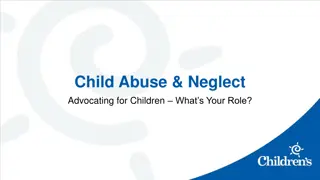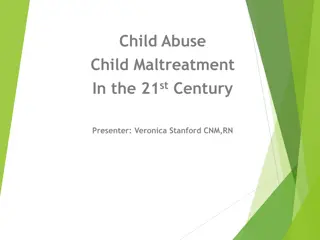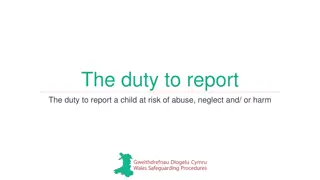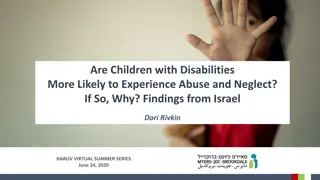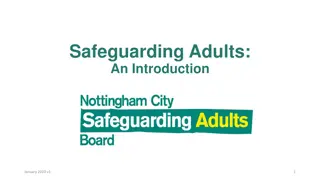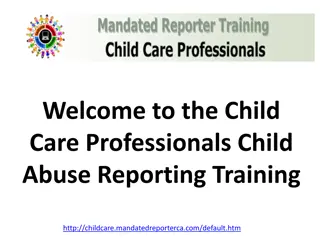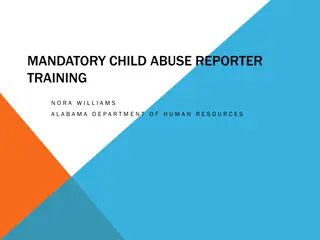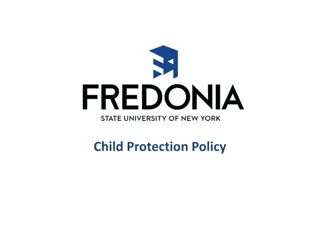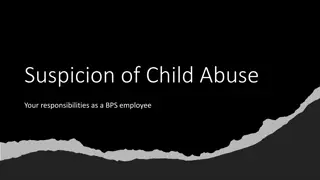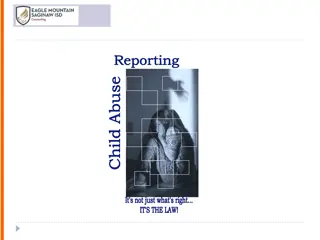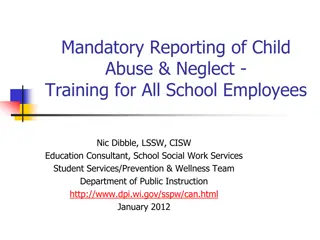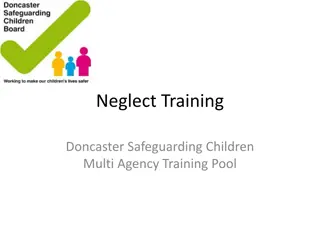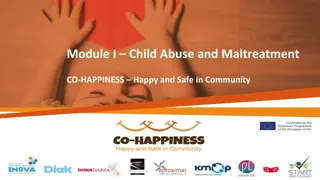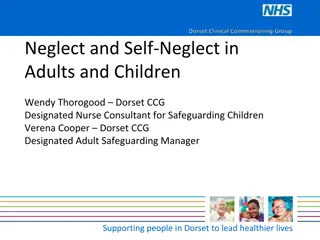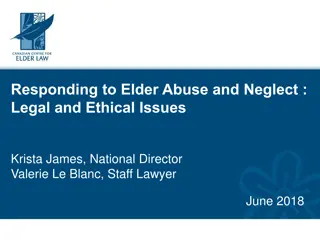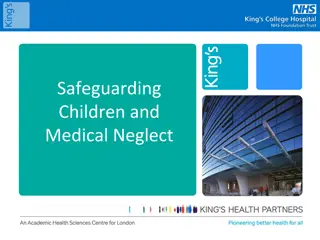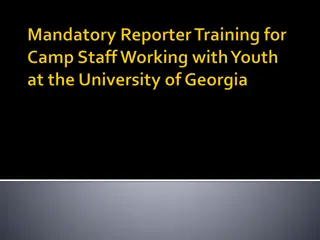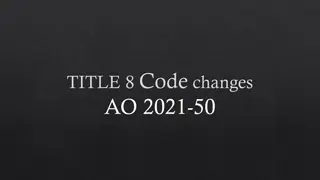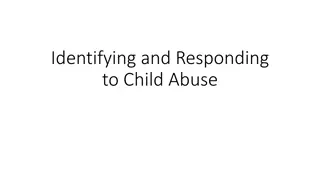Tragic Cases of Child Abuse and Neglect in the UK
The cases of Victoria Climbié, Child BR, Child C, and Child H shed light on the devastating effects of child abuse and neglect in the UK. Victoria suffered 128 injuries before her death due to abuse and neglect. Child BR's death was a result of complications from a chronic health condition, highlighting issues with care and interventions. Child C experienced serious sexual abuse despite previous protection plans, emphasizing the need for better safeguarding measures. Child H suffered non-accidental head injuries, raising concerns about the failings in protecting vulnerable children.
Download Presentation

Please find below an Image/Link to download the presentation.
The content on the website is provided AS IS for your information and personal use only. It may not be sold, licensed, or shared on other websites without obtaining consent from the author.If you encounter any issues during the download, it is possible that the publisher has removed the file from their server.
You are allowed to download the files provided on this website for personal or commercial use, subject to the condition that they are used lawfully. All files are the property of their respective owners.
The content on the website is provided AS IS for your information and personal use only. It may not be sold, licensed, or shared on other websites without obtaining consent from the author.
E N D
Presentation Transcript
THE VICTORIA CLIMBI CASE There were 12 chances to save the life of this eight year old girl. Instead, she died of 128 injuries. How could a child in Britain die like this?
On 25 February 2000, months of abuse and neglect finally overcome Victoria Climbi and she s declared dead. The torture she s suffered includes starvation, cigarette burns, repeated beatings with bike chains and belt buckles. And hammer blows to her toes. But the London doctors who declare this little African girl dead believe her name is Anna.
December 2014 Blackpool - Child BR Death of a 15-year-old in early 2014, as a result of complications caused by a chronic health condition. Background: Child BR was receiving care from a tertiary health centre, geographically remote from their home town. Child BR was made subject to a Child Protection plan on the grounds that Child BR was resisting medical intervention, concerns of parental neglect and parental inability to endorse attendance at medical appointments. Parents had agreed to a bespoke residential plan to improve Child BR s access to health care; Child BR died before the plan could be implemented. Learning: scope for exploring joint working practices between tertiary and primary health services, including the role of the GP as the repository of all health information; when brief interventions are successful ways to maintain them should be explored; and commissioners of specialist health services should consider prompt access to psychological services for children and young people with chronic conditions.
December 2014 NSPCC on behalf of unnamed LSCB - Child C Serious sexual abuse of a 5-year-old girl. Background: Child C s second cousin, OF, pleaded guilty to charges including rape of a female child under 13-years-old and was sentenced to 13 years imprisonment in January 2014. Child C had previously been subject to a Child Protection plan under the category of sexual abuse in relation to an identified risk posed by her paternal step-grandfather and paternal great-uncle, both convicted sex offenders. Key issues: extensive and complicated family networks of Child C s parents; frequent moves between local authorities; use of private landlords for accommodation removing the involvement of housing professionals, making usual organisational contact more difficult; plans focusing on risk of sexual abuse despite significant evidence of neglect; and lack of apparent safeguarding oversight in out of hours service. Learning: need for agencies to be sure that parents are able to fully understand what is being asked of them; and a need for healthy professional curiosity and challenge.
December 2014 - Tameside Child H Non-accidental head injury of a 2-year-old, Asian Muslim child in June 2013. Mother was convicted of Child Cruelty and sentenced to 20-months imprisonment. Background: Family moved to the UK from Asia in 2011. Due to issues with visa applications Child H did not join the family until 2013, aged approximately 2-years- 7-months. Family were known to agencies, following a number of incidents including allegations of shaking involving Child H's siblings and domestic abuse. Key issues: gaps in agency knowledge of family history; focus on evidence-based assessment and outcomes and a lack of confidence in professional assessment of family functioning; and dismissal of child protection concerns on the grounds of misunderstandings due to language barriers. Recommendations: need for a professional culture of respectful uncertainty; need for more robust systems of management oversight in Child in Need cases; and need for further embedding safeguarding processes in the role of the GP. Model: hybrid approach.
November 2014 Tower Hamlets - Jamilla Death of a 4-month-old girl in October 2013, suspected to be caused by malnutrition. Background: Mother was charged with causing or allowing the death of a child and the neglect of Jamilla and her two older siblings; she pleaded guilty to manslaughter and cruelty. Mother was born in the UK to a Somali mother and white British father. Mother was taken to live in Somaliland aged 12 where it is understood that she was forced into marriage at 13 and experienced domestic abuse and rape. Mother was nearly 18-years-old and pregnant with Jamilla when she returned to UK with the help of the Forced Marriage Unit (FMU) and her father. Mother's care of Jamilla and siblings was assessed as good, despite her age and vulnerabilities. Learning: identifies themes, including the rapid deterioration of home circumstances, highlighting that neglect can lead to risk within a very short period of time for babies and young children; and the impact and potential addictive features of social network use on parenting capacity. Identifies findings including focus of assessments on current levels of functioning within families, with insufficient consideration of the potential risks of ongoing vulnerabilities; practitioners not obtaining an understanding of the implications for mother of being dual heritage and lack of knowledge of family's views to mother having escaped a forced marriage; and the need for challenging the myth of persistence in neglect. Recommendations: makes recommendations covering agencies including the FMU and housing services. Model: used a locally developed systems approach, based on the Social Care Institute for Excellence (SCIE) model.
October 2014 Bedford Child A1301 Death of a 19-month-old child in April 2013, as the result of a non- accidental head injury. Background: Child A s mother and her partner were arrested but it was not possible to establish who caused the injury. Child A s parents separated almost immediately after Child A s birth and mother entered into a new relationship. Parents separation was acrimonious; allegations were made against father and against mother. Key issues: preconception of father as controlling leading to his concerns over mother s parenting being minimised; insufficient challenge to information provided by mother, which was later found to be untrue; and drink-driving allegations made against mother not being shared with the police agency responsible for assessing potential harm to children. Model: uses the Social Care Institute for Excellence (SCIE) systems model to identify learning, covering: risks associated with delayed first presentation in pregnancy; and the mechanism for identifying and sharing safeguarding issues raised via Crimestoppers.
Neglect and serious case reviews Systematic analysis of neglect in serious case reviews
http://www.theguardian.com/soci ety/2001/sep/24/childrensservices http://www.theguardian.com/society/2009/may/22/b aby-p-timeline


